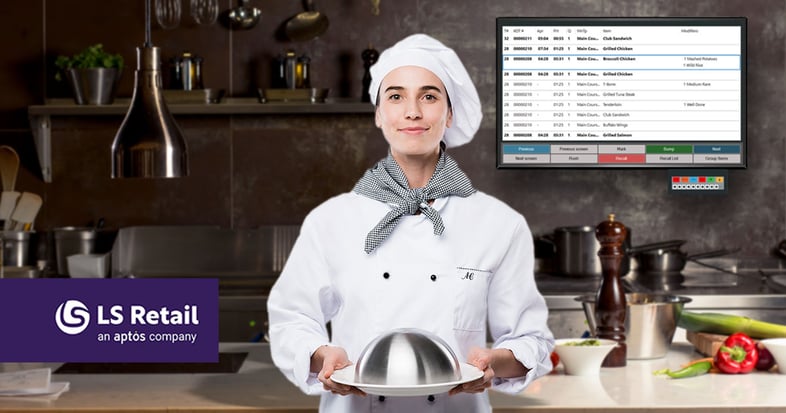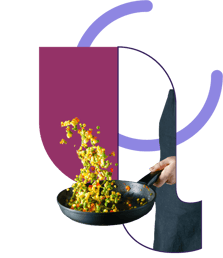Kitchen Display System (KDS): why your restaurant kitchen needs it

How do you manage your kitchen operation today? If you’re still using handwritten paper notes or printed tickets to process orders, then you’re not alone. But you could be missing out on a real opportunity.
In pursuit of greater efficiency, more restaurants are turning to technology to replace their kitchen printers and manual processes. This technology is called Kitchen Display System (KDS), and it has the potential to completely transform your back-of-house operations.
What exactly is a Kitchen Display System?
A KDS is a digital menu board for your kitchen staff. It acts as a traffic officer between the front of house staff and the kitchen and can be customized to follow your kitchen’s flow, enabling you to:
- Route orders to the proper food preparation stations
- Organize items, so dishes that should go out at the same time are prepared in the right order
- Alert kitchen staff when orders have been in the queue too long
- Bump dishes to different stations or mark when they are ready
- See the status of dishes on the POS, so your front of house staff can pick up orders as soon as they are ready. They can also use this information to share updates with customers.
Whether your business is big or small, here are eight reasons why you should consider introducing a KDS to your restaurant kitchen operation.
1. No more lost orders
It’s a common scenario: your waitstaff takes an order, it prints in the kitchen, and the ticket is added to the rack. But amid the chaos of a busy service, the ticket might fall off, get misplaced, or accidentally be removed too early. This small mishap can throw your service into disarray. Kitchen staff scramble to prepare the missed order—or worse, don’t notice the mistake until a customer complains about the delay.
A KDS takes this problem out of the equation altogether. By automatically displaying new orders and sorting them into clear, logical queues, the KDS ensures kitchen staff always have a complete, up-to-date view of what needs to be prepared—preventing lost orders and ensuring no dish is left behind.
2. Dishes prepared in the right order, at the right times
Restaurants use a KDS to clearly see orders coming through from the restaurant floor. Screens show what’s in the queue and how long it’s been there. Orders are prioritized and highlighted when they need to be made to ensure food is served hot and fresh.
A KDS also highlights critical details such as special requests, menu customizations, dietary requirements, and allergy information—updating kitchen staff in real time. If a customer changes their mind after placing an order, such as requesting no mayo on their burger, the update from the POS immediately reflects on the KDS, flagging the change for the kitchen team. This way kitchen staff can accommodate requests, avoid unnecessary food waste, and still ensure that the entire order arrives at the table simultaneously. The result? An organized kitchen where staff know exactly what they need to do and when.
3. Clearer workflows in the kitchen
A KDS takes the confusion out of a busy service. Orders are automatically routed to the appropriate workstations — for example, items destined for the grill are sent there, while salads are directed to the salad station. This increases efficiency in the kitchen by keeping staff focused at their stations, allowing them to complete more orders without the need for shouted instructions or searching for small paper tickets. Tasks are assigned automatically, and tickets can be completed faster.
What happens if a station falls behind during a rush? With a KDS, you can quickly reprioritize, reroute, or redistribute orders to other prep stations as needed. The system also helps simplify complex orders, making them easier for staff to manage. For example, instead of presenting an order like:
3 cheeseburgers
3 fries
2 club sandwiches
1 chicken Caesar salad
The KDS breaks information down and communicates it clearly so employees can focus on what they need to make at that moment in time. And it also helps chefs keep track of modifications, and know exactly what needs to be prepared for each menu item.
4. Better communication between front of house and kitchen staff

Restaurant guests tend to be unforgiving when mistakes are made. If they ask for no dressing on their salad, they expect exactly that. But when your staff only have a notepad to jot these instructions down on, requests can easily get overlooked or misinterpreted and the inevitable happens: orders go wrong, and you end up with disappointed customers – and perhaps a dish that ends up in the garbage can.
A KDS takes misinterpretation and lost notes out of the equation. No menu request or change becomes too much for your staff to handle – no illegible long lists or quickly scrawled notes to decipher. Waiters update their POS and the information is communicated in real time to the kitchen. And the communication channel works both ways. So when front of house staff need an order update, they can easily check their POS to see what’s happening in the back.
5. Food at top quality when it reaches the table
When dining out, few things are as disappointing as being served a meal that's gone cold—unless, of course, it’s supposed to be! For items like fries, which can lose their heat quickly, it’s crucial for kitchen and waitstaff to act promptly as soon as dishes are ready.
The KDS ensures that all orders per table are synchronized so that meals come out at the same time, at just the right temperature. It can be set so that items that are likely to turn cold quickly are flagged before they’re ready, giving front of house staff time to collect orders just as they’re being served up.
6. Well-coordinated and speedy service
Picture the scene: One of your front of house staff has just taken a large table order. But on their way to the kitchen to deliver their hand-written note, they get called over by another table who are also keen to order. Five minutes later, and the kitchen staff are still unaware of the large food order coming their way. In that time, they could have begun to prepare the food, but instead they’re waiting for the paper ticket to be handed over.
With a KDS, these delays are taken out of the equation. Front of house staff are no longer under pressure to memorize orders or write down notes that need to be hand-delivered to the kitchen. Instead, orders are sent to the kitchen immediately. Chances for miscommunication and error are minimized. If required, you can also organize orders by seat to ensure there are no interruptions, and no risk of giving a customer the wrong dish. This kind of attention to detail will also make your general service feel more polished and professional.
7. An environmentally friendly and sustainable business
Running a more sustainable kitchen operation not only reduces your impact on the environment but it makes good business sense. By cutting down on food waste and planning better for every service, restaurants save money and appeal to environmentally conscious consumers.
A Kitchen Display System (KDS), when connected with a smart restaurant POS, helps minimize errors and discrepancies in orders, significantly cutting down on waste. Clear, accurate communication ensures your kitchen operates efficiently and avoids unnecessary food loss.
And by doing away with kitchen printers, just think of the amount of paper you will save. Printing off your daily orders may not seem like a huge expense or waste in the grand scheme of things, but it quickly adds up. An average roll of printer paper costing around US$5 covers roughly 450 orders. That works out at just over one cent per paper ticket, not to mention the higher cost of printer ink. Consider roughly how many orders your restaurant kitchen takes per day and then think about the savings – and the positive environmental impact – you’d make by eliminating paper tickets altogether.
8. More accurate management of takeaway orders
Food delivery apps, like Deliveroo, have seen rapid growth, with revenue increasing over 650% year on year. Restaurants partnering with these platforms report revenue boosts of up to 30%.
As restaurants explore the opportunity of takeaway orders to expand their reach and customer base, many worry about the impact this will have on their kitchen operation. Will the introduction of online orders and takeaway services impact their business model and throw their kitchen into disarray? Not if it’s handled with the right technology.
A KDS smoothly routes orders from online ordering systems directly to the kitchen, without the need for staff members to manually enter information. If required, you can set the system so that online orders must be approved by a manager before they reach the kitchen. But the overall result is that online and takeaway orders are fully integrated into your kitchen operation without any extra effort. And in the kitchen, take-out orders can be clearly marked as such on the screens, to ensure that they are prepared and packed appropriately instead of being plated up.
Is your kitchen ready for smoother operations and better organization? Discover how a KDS can simplify your restaurant workflow and eliminate error-prone manual processes. Contact our team of experts to learn more!

